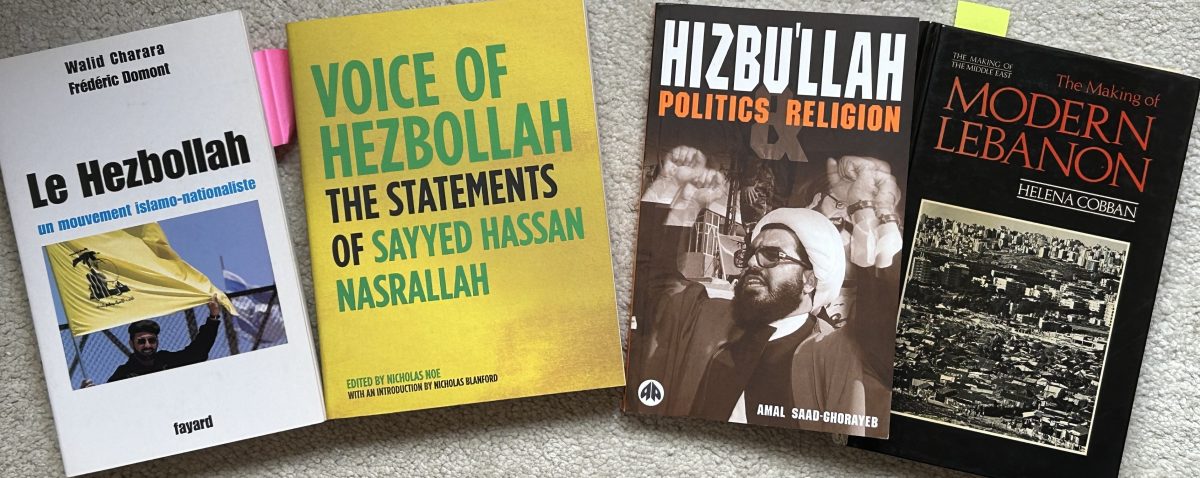There is so much to be said about the horrrendous escalations that Netanyahu’s government and military have been undertaking in Lebanon since the grotesque, booby-trapped pager attack they launched September 17. First, my deepest condolences to all those families, individuals, and communities devastated by these escalations. (Those impacted by them do include many Israelis caught in Hizbullah’s blowback to Netanyahu’s escalations. But the carnage on the Lebanese side thus far seems to have been far, far more serious and widespread.)
Prior to September 17, there was a precarious balance of deterrent terror between Israel and Hizbullah– one that the Hizb had established back in 2006 when it successfully and speedily cleaned the Israeli military’s clock as the outcome of Israel’s last major escalation in Lebanon. But clearly, in the lead-up to last week’s “pager attack” and the other escalations that speedily followed it, Netanyahu had taken a decision to majorly upset that deterrent balance.
Sec0nd, it’s worth noting that Netanyahu’s decision(s) to escalate at this point came in the context of the political battles he has been fighting both at home, and internationally– primarily to avoid being held accountable for the numerous, very serious domestic-political and laws-of-war violations for which he is responsible.
Also worth noting: the ease with which Netanyahu has brushed aside– in Lebanon as in Gaza– any attempt by Joe Biden to be even a minimally effective “mediator” in these conflicts.
American “mediation” is now seen worldwide as a cracked and empty vessel.
…Since people in the “West” do not know much about Hizbullah except what they are told by the corporate media, I thought it worthwhile to dig back through some of the books on the topic — and some of my own writings on the topic–that I’ve found useful over the years.
The books I’ve found most useful are the three on the left in the banner image above…
One of the main canards/allegations about Hizbullah in the Western corporate discourse is that it is primarily an “offshoot” or a “tool” of the Islamic Republic of Iran.

I addressed that canard head-on in a 12-page paper that I published back in 1985, which you can now download and read here (29 MB.) That little paper still has some utility these days as a quick primer on the background and nature of the Shiite community in Lebanon.
It includes:
- a Chronology of the Shiites’ long presence in the country, dating back to the early years of Islam in the 7th century CE;
- a sidebar on the relationship between this Shiite community and the much larger and more powerful one in Iran– including the fact that when the the Safavid ruler of Iran decided in the early 16th century, probably for geopolitical reasons, that he wanted his subjects and his country to become Shiite, it was teachers from Lebanon that he brought in to effect this conversion;
- a rough graph of the demographic balance among the different religious communities in Lebanon and how it has shifted in favor of the Shiites between 1932 and 1983. (Doubtless it has shifted a lot more in the 40 years since then.)
That 1985 paper had evident shortcomings. I was writing it at a time when Hizbullah had not even been formally founded! The main Shiite political force at that time was the Hizb al-Amal (“Hope Party”), which became nearly fully eclipsed over the years that followed, though it does still exist. The only references I made in that paper to the sprigs that would later coalesce into Hizbullah were references to various shadowy “extremist” networks that seemed to be putting pressure on Amal.
But still, I am glad I did that bit of work back in 1985. It was a small spin-off from the book that I’d just finished writing, The Making of Modern Lebanon (originally published by Hutchinson in 1985; still in print.)
There were a couple of interesting stories behind the publication of that short paper. One is that it was the DC-based Middle East Institute that commissioned it. In more recent years, MEI has become so deeply enmeshed in the Sunni-fundamentalist regime-change project in Syria that I am pretty sure it would not even consider publishing anything that looks at all objectively at the history of Shiites in Lebanon, or anyplace else.
Another interesting aspect is that the MEI person with whom I worked most closely on the paper– as shown on p.2 of the PDF– was the distinguished retired U.S. ambassador Chris Van Hollen. His son Chris Van Hollen is now a Democratic Party senator for Maryland, and one of the least ignorant and least warlike members of the Senate Foreign Relations Committee. (He also looks eerily like his late father.)
Fast-forward to 2005: in April 2005 I published this fairly substantial assessment of Hizbullah in Boston Review. In the intervening 20 years Hizbullah had emerged as a stable and well organized party within the Lebanese political system, where by 2005 it led a 12-member bloc in the country’s 128-member parliament. Crucially, however, in 1996 Hizbullah’s military wing had been able to decisively fend off a major assault the Israelis launched against them under the rubric “Operation Grapes of Wrath.” And though Israel’s ground forces remained in Lebanon for a further four years, by 2000 their position had crumbled so decisively that they simply packed up their bags and left, taking with them the remnants of the proxy army they had sought to install there.
In my 2005 article, which included interview material with several Hizbullah officials, I traced many of those developments.
Hizbullah’s 1996/2000 victory marked the decisive end of a military presence the Israelis had maintained inside Lebanon since 1978. However, one year after my 2005 essay was published a new Israeli Prime Minister, Ehud Olmert, came to power determined to “teach Hizbullah a lesson” and to restore the “credibility” of Israel’s ability to decisively “deter” its opponents. In July 2006, Hizbullah provided the pretext for the new Israeli assault that Olmert craved by sending a squad into northern Israel to kidnap two Israeli soldiers. (An eery precursor to Hamas’s Operation Al-Aqsa Flood of 17 years later…)
In 2006, the violence the Israelis unleashed against the whole of Lebanon including numerous items of vital civilian infrastructure was hasrh, widespread, and speedy–much more so than the long slog with which they had “conquered” one-third of Lebanon back in 1982. They also, as in 1978 and 1982, sent in ground troops to try to seize and hold land.
In 2006, Hizbullah’s leaders seemed (or later claimed to have been) briefly surprised by the ferocity of the Israeli assault. But their forces were essentially ready to meet it; and within just 33 days they had sent Israel’s invasion forces packing in a considerably more humiliating reprise of the withdrawal they had been forced to undertake six years earlier…
In November 2006, I wrote this appraisal of the 33-day war of 2006, which once again was published by Boston Review.
I haven’t written much about Hizbullah in the 18 years since then. But I think people might find some of my earlier work on the topic to have some value.
As for my expectations about what might happen this time, I am still thinking it through, though I think the repercussions at the global level may well– when judged alongside the repercussions from the US-Israeli genocide in Gaza– be much more significant than the repercussions from happened in 1982, 1996, 2000, or 2006.
This time around, the balance among the world’s big nations and what remains of the integrity of the post-1945 global order both feel as though they are poised on a knife-edge… And here in Washington DC, there is, as I have noted before, no discernible hand steering the ship of state…


